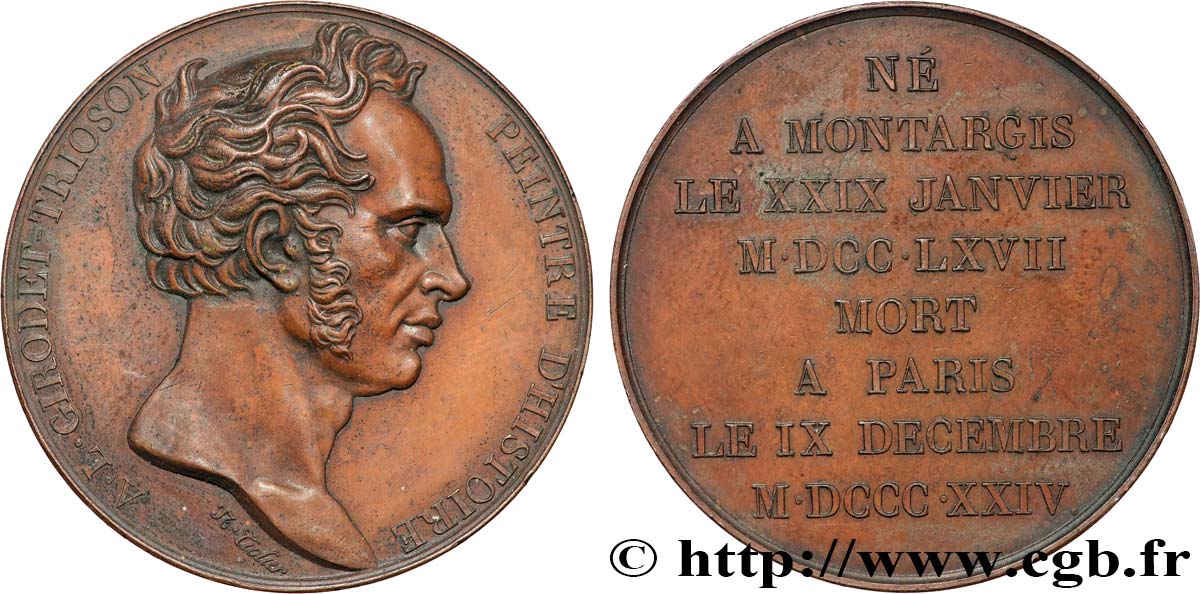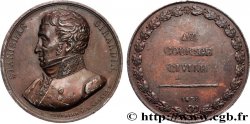65.00 €(Approx. 75.40$ | 56.55£)
Quantity
Add to your cart

Type : Médaille, Anne-Louis Girodet
Date: 1824
Metal : copper
Diameter : 40,5 mm
Orientation dies : 12 h.
Engraver TIOLIER Nicolas-Pierre (1784-1853)
Weight : 36,17 g.
Edge : Lisse
Puncheon : sans poinçon
Coments on the condition:
Patine marron hétérogène avec des taches noires d’oxydation
Obverse
Obverse legend : A. L. GIRODET-TRIOSON - PEINTRE D’HISTOIRE.
Obverse description : Tête à droite d’Anne-Louis Girodet, signé : TIOLIER.
Reverse
Reverse legend : NE / A MONTARGIS / LE XXIX JANVIER / M. DCC. LXVII/ MORT / A PRIS / LE IX DÉCEMBRE / M. DCCC. XXIV.
Reverse description : Légende en huit lignes.
Commentary
Intéressante médaille représentant le graveur Girodet, par le graveur Tiolier, conservée dans la collection du graveur Michaut...
Anne-Louis Girodet, ou Anne-Louis Girodet-Trioson, né à Montargis le 29 janvier 1767 et mort à Paris le 9 décembre 1824 (à 57 ans), est un peintre et graveur français.
L'œuvre de Girodet se situe à la charnière des deux grands courants artistiques du début du XIXe siècle : la peinture néoclassique et la peinture romantique. La recherche de la beauté idéale selon les canons classiques l'inscrit dans la lignée des peintres néoclassiques davidiens dont il est avec Antoine-Jean Gros, François Gérard, et Jean-Auguste-Dominique Ingres l'un des principaux représentants, alors même que, par une forte volonté d'innovation, il imprègne ses peintures d'une grâce et d'une poésie singulière qui préfigure le romantisme..
Interesting medal representing the engraver Girodet, by the engraver Tiolier, preserved in the collection of the engraver Michaut... Anne-Louis Girodet, or Anne-Louis Girodet-Trioson, born in Montargis on January 29, 1767 and died in Paris on December 9, 1824 (at the age of 57), is a French painter and engraver. Girodet's work is situated at the crossroads of the two great artistic movements of the early 19th century: neoclassical painting and romantic painting. The search for ideal beauty according to classical canons places him in the lineage of the Davidian neoclassical painters of whom he is, with Antoine-Jean Gros, François Gérard, and Jean-Auguste-Dominique Ingres, one of the main representatives, even though, through a strong desire for innovation, he imbues his paintings with a grace and a singular poetry that prefigures romanticism.
Anne-Louis Girodet, ou Anne-Louis Girodet-Trioson, né à Montargis le 29 janvier 1767 et mort à Paris le 9 décembre 1824 (à 57 ans), est un peintre et graveur français.
L'œuvre de Girodet se situe à la charnière des deux grands courants artistiques du début du XIXe siècle : la peinture néoclassique et la peinture romantique. La recherche de la beauté idéale selon les canons classiques l'inscrit dans la lignée des peintres néoclassiques davidiens dont il est avec Antoine-Jean Gros, François Gérard, et Jean-Auguste-Dominique Ingres l'un des principaux représentants, alors même que, par une forte volonté d'innovation, il imprègne ses peintures d'une grâce et d'une poésie singulière qui préfigure le romantisme..
Interesting medal representing the engraver Girodet, by the engraver Tiolier, preserved in the collection of the engraver Michaut... Anne-Louis Girodet, or Anne-Louis Girodet-Trioson, born in Montargis on January 29, 1767 and died in Paris on December 9, 1824 (at the age of 57), is a French painter and engraver. Girodet's work is situated at the crossroads of the two great artistic movements of the early 19th century: neoclassical painting and romantic painting. The search for ideal beauty according to classical canons places him in the lineage of the Davidian neoclassical painters of whom he is, with Antoine-Jean Gros, François Gérard, and Jean-Auguste-Dominique Ingres, one of the main representatives, even though, through a strong desire for innovation, he imbues his paintings with a grace and a singular poetry that prefigures romanticism.








 Report a mistake
Report a mistake Print the page
Print the page Share my selection
Share my selection Ask a question
Ask a question Consign / sell
Consign / sell
 Full data
Full data










